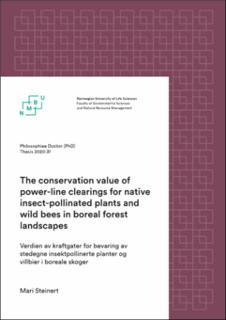| dc.description.abstract | Worldwide declines in wild pollinators are threatening the provision of vital pollination functions and services to both native plant communities and crops. Habitat loss due to human land use changes is identified as one of the main drivers of wild bee decline. Particularly, farmland abandonment and conversion of natural forests into even-aged managed stands have greatly reduced the availability of essential early successional habitats in the landscape. In recent decades, to mitigate the loss of native biodiversity, there has been a growing interest in the conservation management of human modified landscapes. Modified landscape features, such as power-line clearings, can provide valuable alternative habitats for early successional plant species, which in turn offer important flower resources for wild bees.
The main objectives for the four studies in this thesis were to study the conservation value of power-line clearings as habitat for insect-pollinated plant and wild bee communities in forest landscapes and to identify effects of different maintenance
learing practices.
We carried out a large-scale field experiment and an observational study in power-lines clearings. In the first three papers, we studied the experimental treatment effects on insectpollinated plant (forbs, shrubs, and dwarf shrubs) (Paper I), solitary bee (Paper II) and bumble bee (Paper III) communities in response to different vegetation clearing practices (treatments), where woody vegetation was: (i) cut, with woody debris left to decay; (ii) cutremove, with woody debris removed; and (iii) uncut. To study the effects of management practices we used different combinations of taxonomic and functional trait diversity indices or traits groups. We assessed the modifying influence of environmental conditions, and whether the treatment effects were maintained three years post-treatment (Paper I, II, III). In Paper II and III, we used the floral resources from Paper I as important explanatory factors for the wild bee communities. To identify the value of power-line clearings as a pollinator habitat in boreal production forests, we carried out an observational study on bumble bees (Paper IV). We studied the spatiotemporal variation in bumble bee richness and abundance between open habitats in power-line clearings and adjacent forest habitats throughout one foraging season, related to environmental conditions.
Overall, the studies presented in this thesis show that power-line clearings can be important habitats for communities of both insect-pollinated plants and wild bees, and that habitat quality can be enhanced with proper management. We found that cutting the vegetation had a positive effect on plants and wild bees compared to the uncut plots, regardless of woody debris removal (Paper I, II, III). However, the effect of management practices was context dependent. Under certain environmental conditions the removal of woody debris led to a higher richness and functional diversity of plants (Paper I) which promoted a higher functional diversity of wild bees (Paper II, III). For solitary bees, woody debris removal promoted a strong positive effect which was sustained three years after cutting. Bumble bees seemed to thrive in both cut treatments. We found that the powerline clearings are valuable open canopy habitats for bumble bees in managed forests and that the power-line clearings provide essential late-season foraging resources, particularly heather (Calluna vulgaris) (Paper IV).
In forest landscapes, power-line clearings can function as alternative habitats for wild bees in boreal forests and species associated with semi-natural habitats, providing potential nesting substrates and enhanced native flower resources. To improve habitat conditions for the solitary bees, removing the woody debris is highly recommended, whereas to improve habitat conditions for bumble bees, woody debris removal is beneficial, but not as important. Implementation of management efforts should be carefully located to areas of certain environmental conditions to achieve the best possible effect. Additionally, targeted enhancement of flower species with high nectar content or flowers with late phenology (i.e. heather), would further enhance the conservation value. Our results also highlight the importance of open habitats in managed forests and that less dense forest stands are important for wild bee conservation. To conserve native plants and wild bees species, the populations need to be maintained at a landscape level. Hence, management practices should be implemented in areas enabling connectivity between open semi-natural habitats in the landscape.
Recommendations for overall wild bee conservation would thus be to implement a mosaic of woody debris retention and removal in power-line clearings, to support diverse wild bee communities. Together, the findings of this thesis represent a foundation for developing pollinator-friendly management strategies in power-line clearings in forest landscapes and suggest how power-line clearings should be included in integrated conservation plans. | en_US |

